Georgia Under 21s have picked up some impressive results in their debut U21 European Championships campaign. The hosts have seen record crowds come out to support them as they topped Group A thanks to a victory over Portugal and two draws with Belgium and The Netherlands. Although their tournament ended with a loss on penalties to Israel, the U21 Euros has seen excellent displays from a vast array of talented young Georgian players.
Whilst many media outlets are commenting that Georgia’s results were something of a surprise, and maybe they were. Truthfully, if we look at the bigger picture, we can see a renaissance of Georgian football taking place. The dazzling displays of Khvicha Kvaratskhelia for Napoli in their Serie A winning season has shone more of a light on Georgian players; however, there are plenty of other talented Georgian players emerging from the Erovnuli Liga and beyond.
In this tactical analysis which will take the form of a scout report, we will look into three players that have the potential to fuel an entire golden generation for the national team. We will analyse how these players are utilised in the tactics their coaches use at club level. Additionally, we will provide an analysis of their overall style of play and the skillset each player possesses.
Giorgi Moistsrapishvili – Dinamo Tbilisi
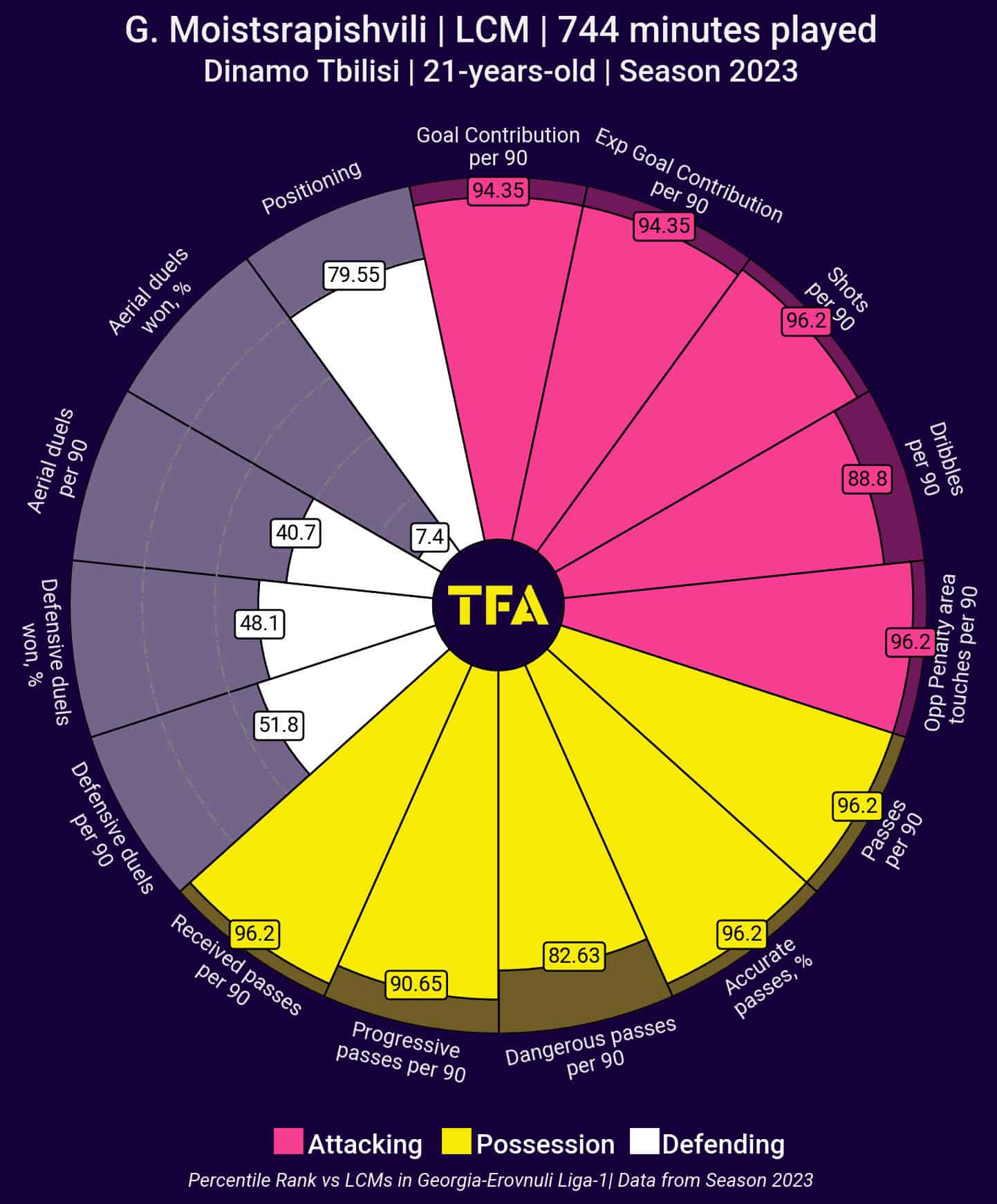
The first player we are going to look at in this tactical analysis is Dinamo Tbilisi midfielder Giorgi Moistsrapishvili. The 21-year-old has impressed at club level when given opportunities this season and is proving that he can go on to be an essential player for Georgia. The young midfielder is able to play as a traditional box-to-box central midfielder, in a more defensive position or as a number 10, which is where he has been playing for Georgia U21s at the Euros this summer.
The pizza chart above allows us to compare Moistsrapishvili to players who play in the same position as him in the Erovnuli Liga this season. Firstly, we can clearly see that he struggles aerially as he fails to win most of his aerial duels, which is interesting for a player who is 183cm tall. However, we can understand that Moistsreapishvili is able to showcase good defensive positioning, which means that he is in the right place at the right time to intercept the ball and make tackles to halt the opposition’s attacks.
In possession is where the 21-year-old really shines as we can see, he is incredibly reliable with his passing. He is often able to use his ability to carve out an opening for a teammate or to take several opposition players out of the game, creating space for others. Of course, Dinamo Tbilisi is one of the stronger teams in the Erovnuli Liga. Therefore, they see more of the ball than other teams, but the way Moistsrapishvili utilises the possession to Dinamo’s advantage is impressive.
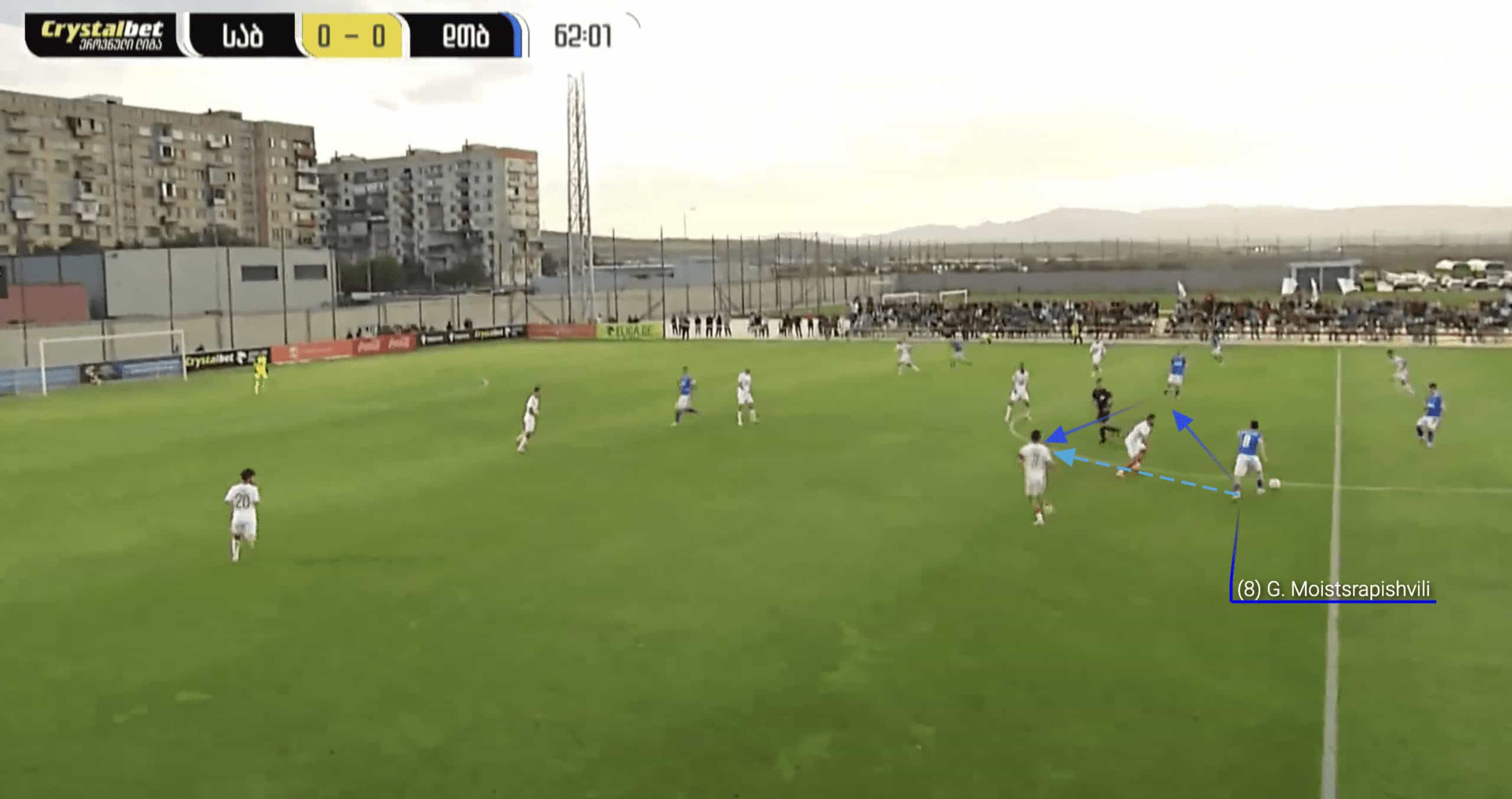
Here, for instance, we can see how well Giorgi Moistsrapishvili works in small areas of space. He is able to link up with a teammate by playing a quick one-two which sees him breeze past the three opposition players surrounding him. The ability of the young Georgian midfielder to link up with a teammate in tight areas demonstrates his technical prowess and composure under pressure as he shows quick thinking and precise passing skills. By successfully manoeuvring through tight spaces, Moistsrapishvili can bypass opposition players and create openings in the defence.
Moreover, Moistsrapishvili’s ability to link up play enhances Dinamo Tbilisi’s ability to maintain fluidity and control over the game. By combining short, intricate passes, the central midfielder and his teammates can keep the ball moving within the confined spaces, which makes it difficult for the opposition to regain possession. This not only frustrates the opposition but also allows Moistsrapishvili and the Dinamo midfield to dictate the match’s tempo. Furthermore, the intricate passing sequences also help them to build a rhythm and establish a cohesive playing style.
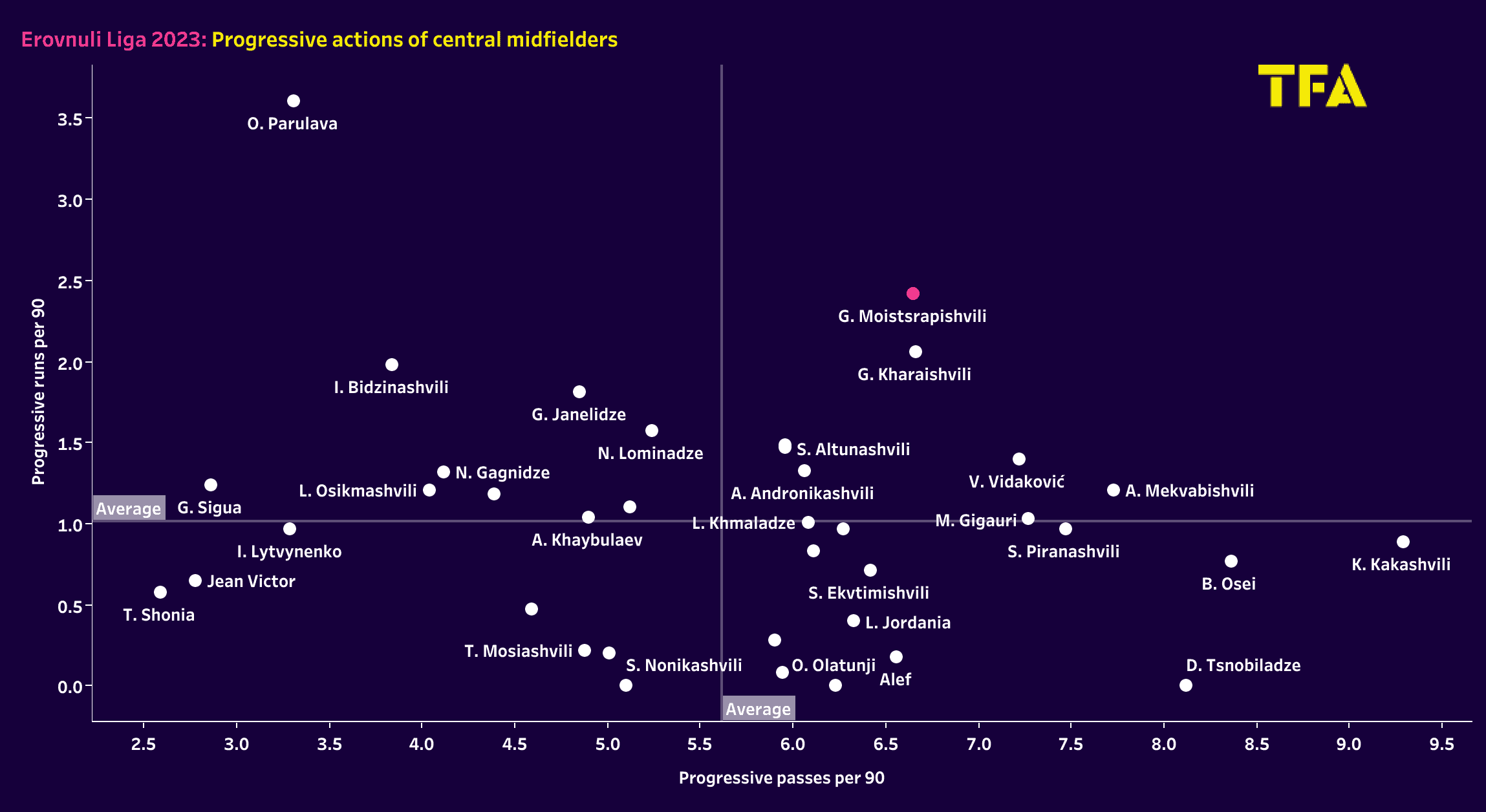
The data visual above allows us to compare how the 21-year-old compares to fellow Erovnuli Liga central midfielders regarding progressive actions per 90. We can see that he performs above average in both metrics, contributing 6.65 progressive passes per 90 and 2.42 progressive runs per 90; these statistics are impressive considering that Moistsrapishvili has played 744 minutes of football so far this season, as per the pizza chart.
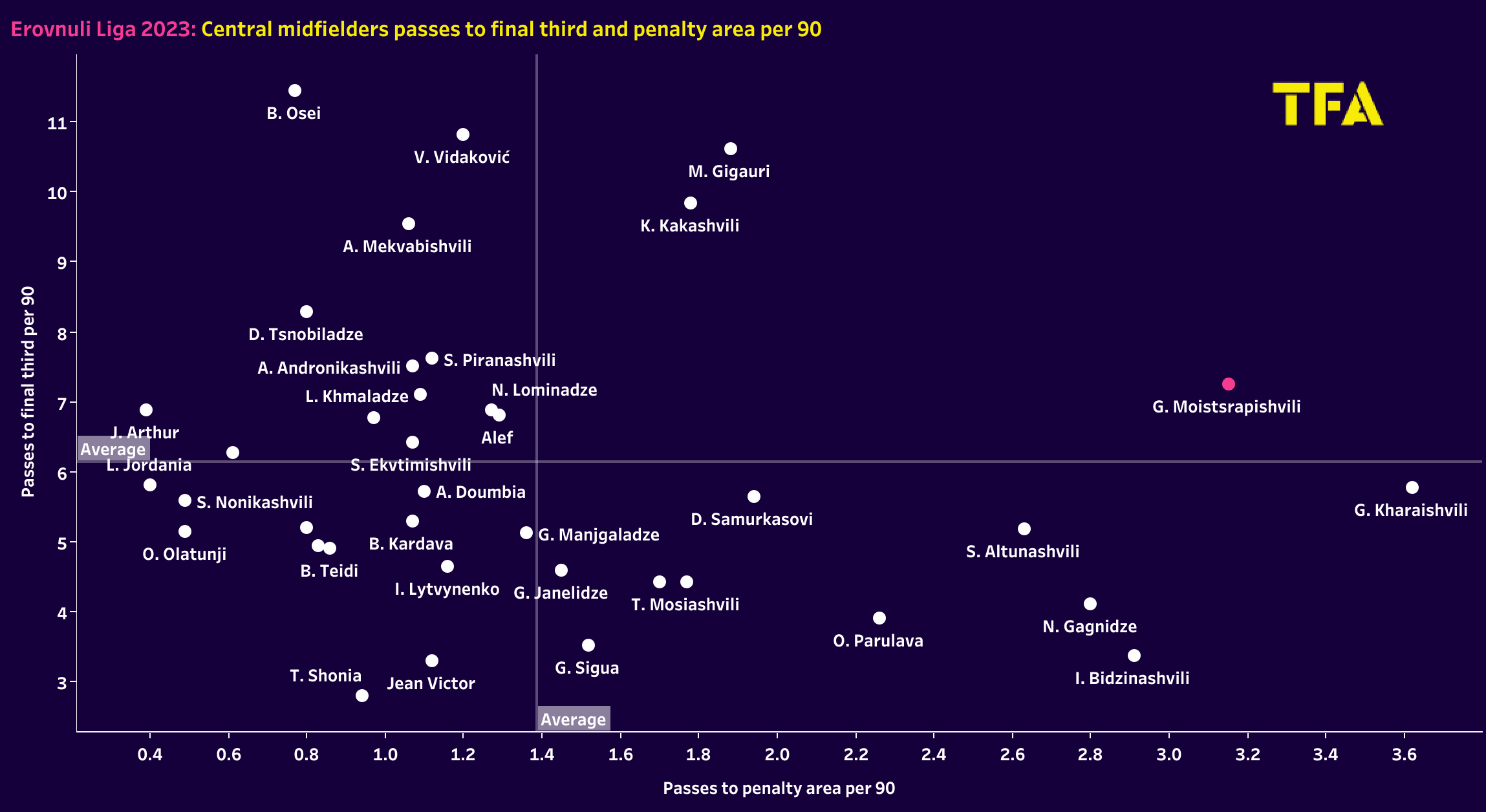
Furthermore, looking at the data visual above, we can understand that the attack-minded midfielder consistently looks to play passes into the final third and the opposition penalty area. He averages 7.26 passes to the final third per 90, combined with 3.15 passes to the penalty area per 90 means that Moistsrapishvili has the potential to be creatively very dangerous. Given that he has only contributed two assists so far this season, it is fair to say that perhaps these passes do not always reach their intended targets, or upon receiving the ball, teammates are unable to work an opening to get a shot away at goal.
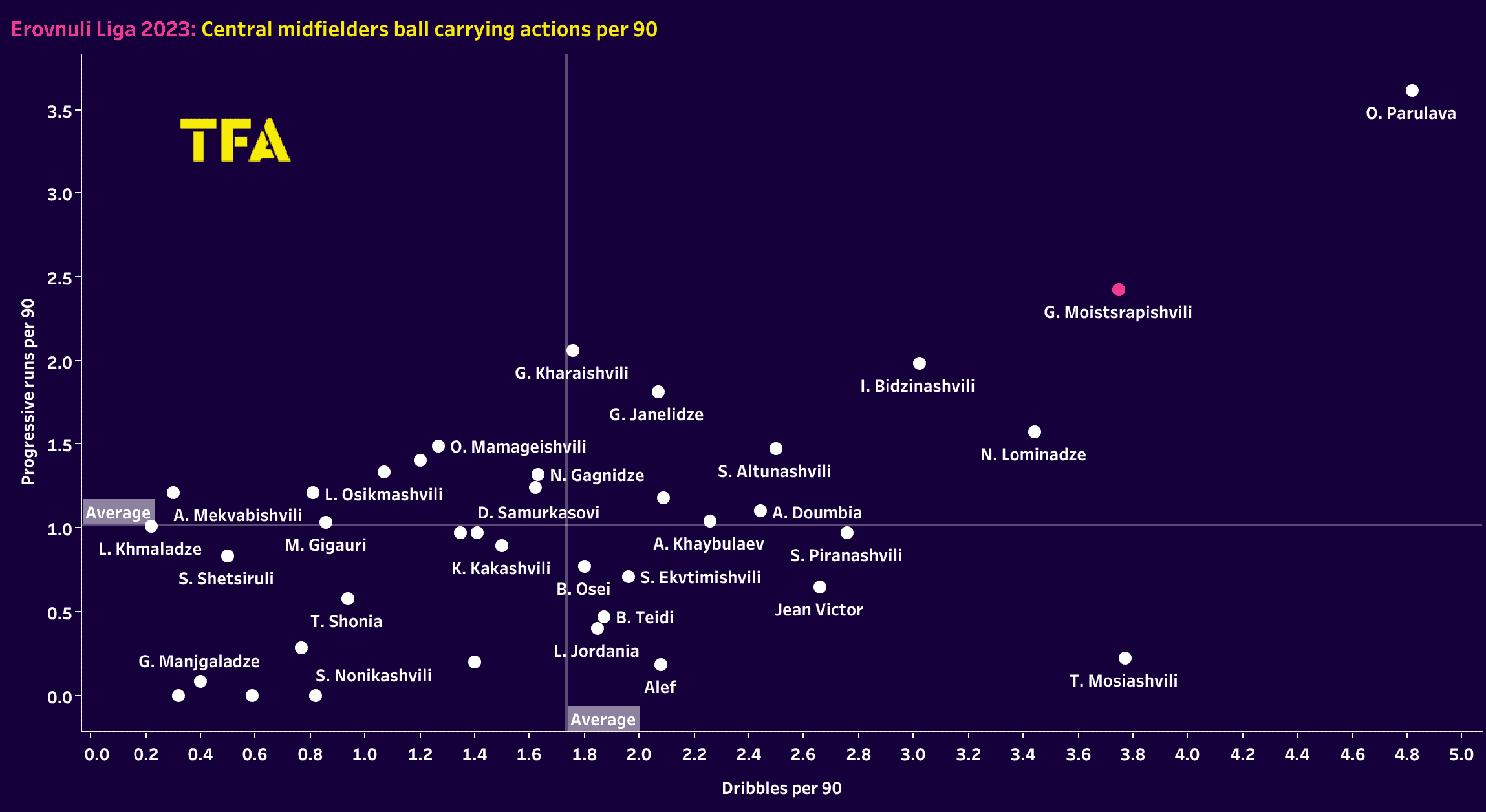
Moving on, if we look at this data visual above, we can see how the Dinamo Tbilisi man performs in terms of ball-carrying actions per 90. Averaging 3.75 dribbles per 90, second only to Otar Parulava, we can infer that Moistsrapishvili is more than capable of carrying the ball up the pitch as Dinamo Tbilisi looks to transition from defence to attack.
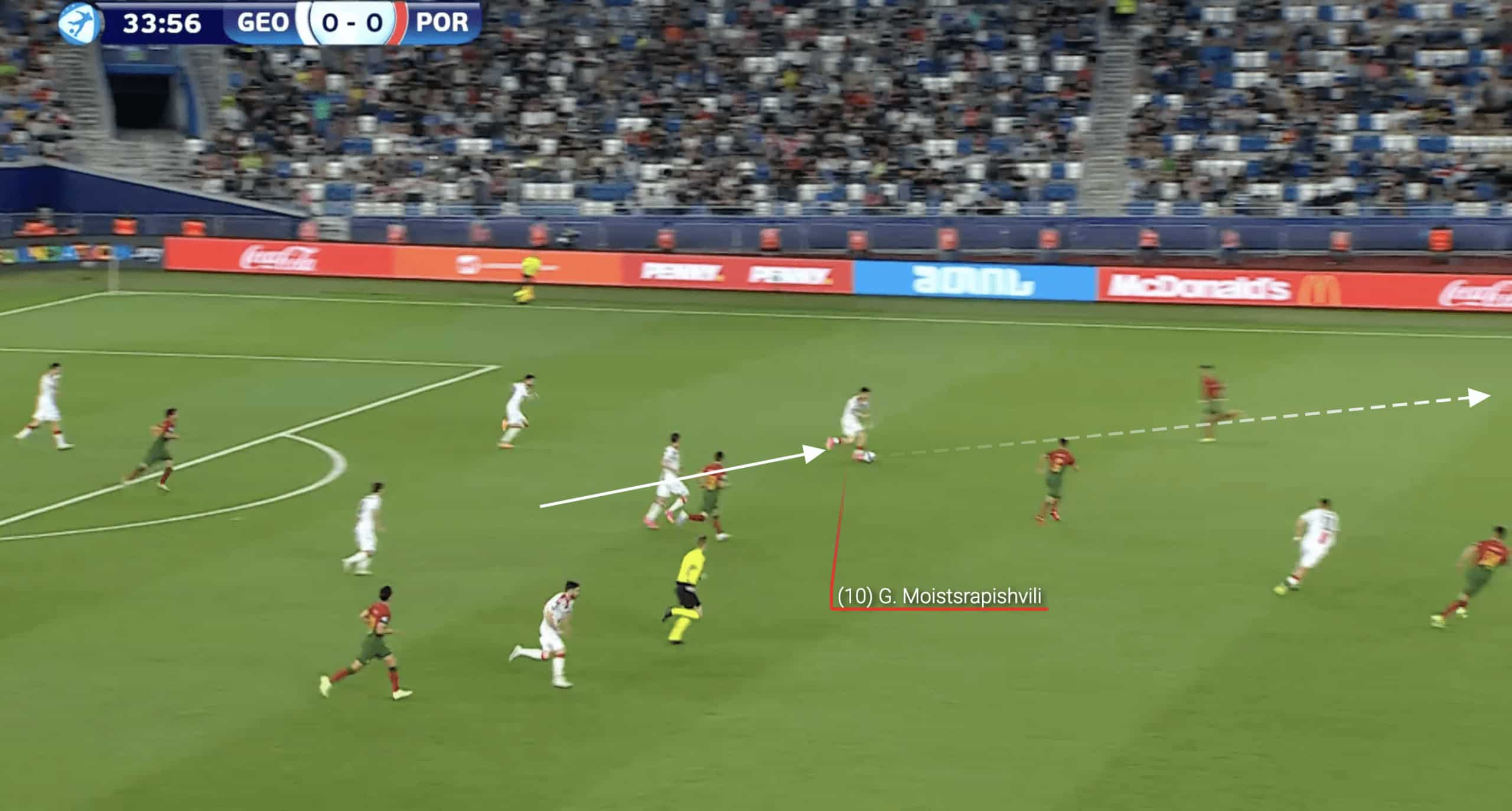
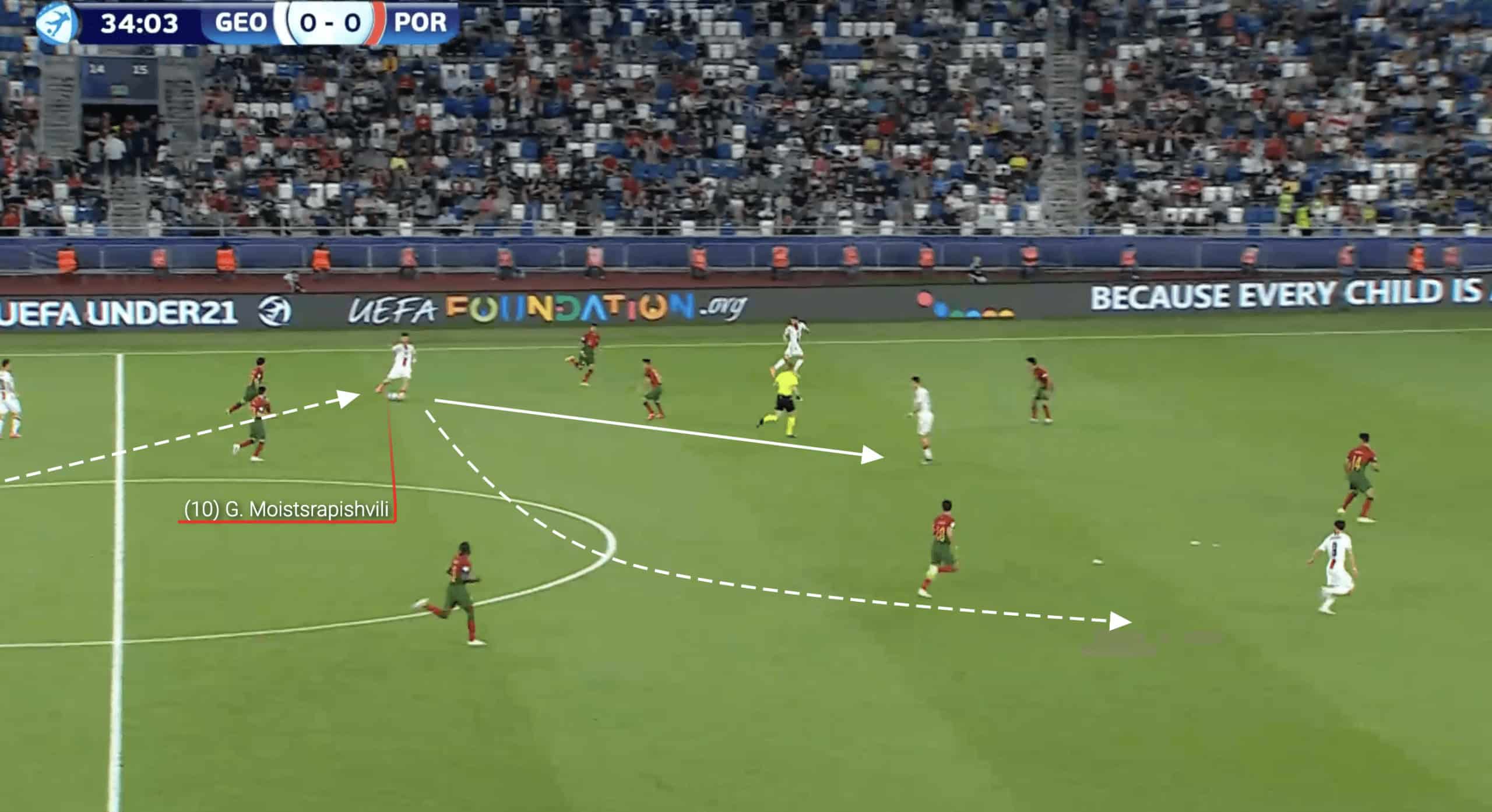
These images above demonstrate how Moistsrapishvili utilises his dribbling ability to enable his team, Georgia U21 in this case. We can see that he receives the ball on the edge of his penalty area and is able to carry possession into the opposition’s half before passing the ball to a teammate and continuing his run into space.
We can also see from the visual below that he likes to carry the ball into the penalty area, as he has contributed 29 penetrating carries so far this season. Many of these carries begin in the half-spaces as Moistsrapishvili likes to drift into pockets of space in these areas to receive the ball in the attacking phase. This forces the opposition defenders to split their attention between marking the forwards and tracking the Georgian midfielder’s runs. This diversion of defensive focus increases the likelihood of confusion or mismatches, allowing Moistsrapishvili to find space and potentially score or create scoring opportunities for others.
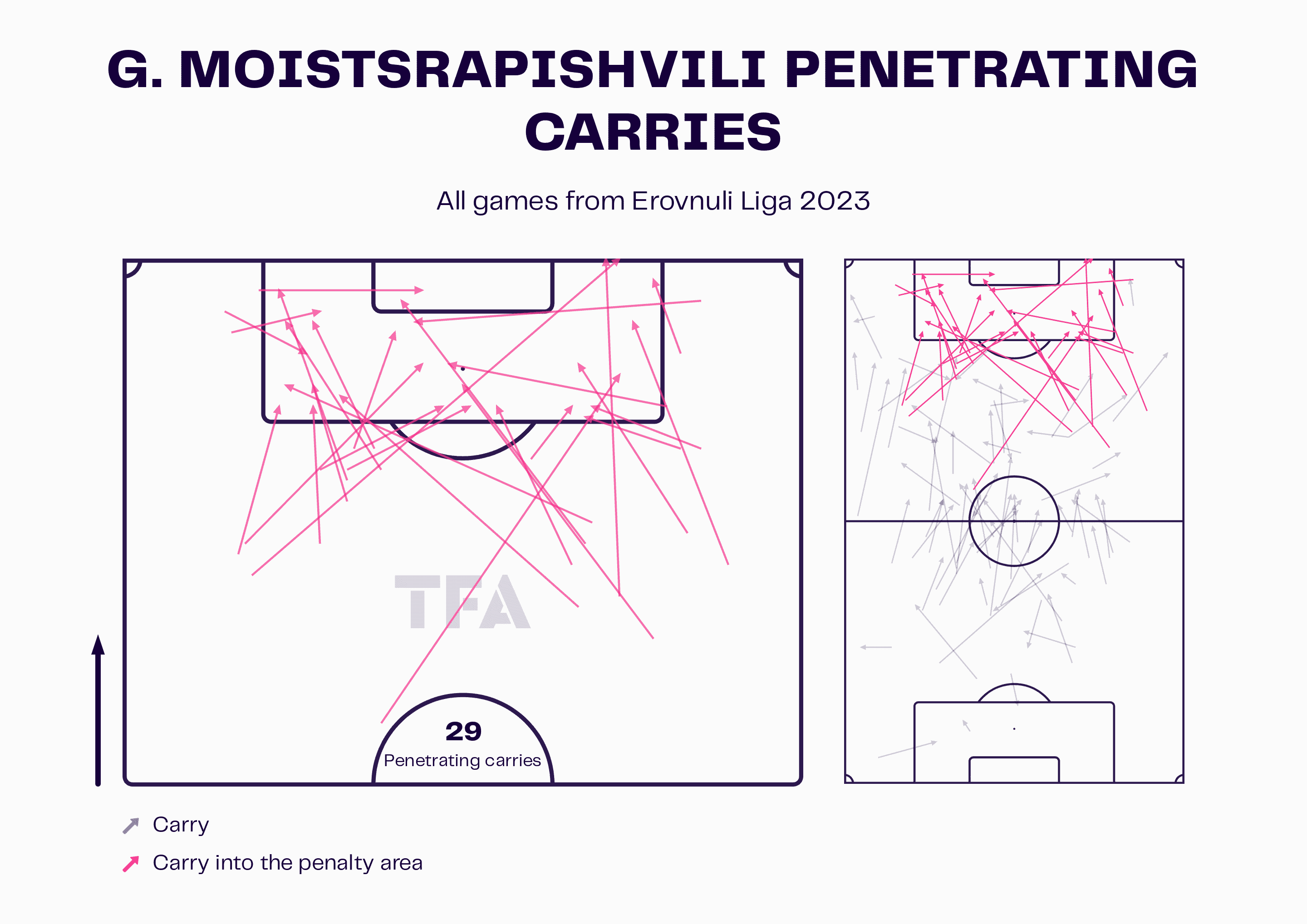
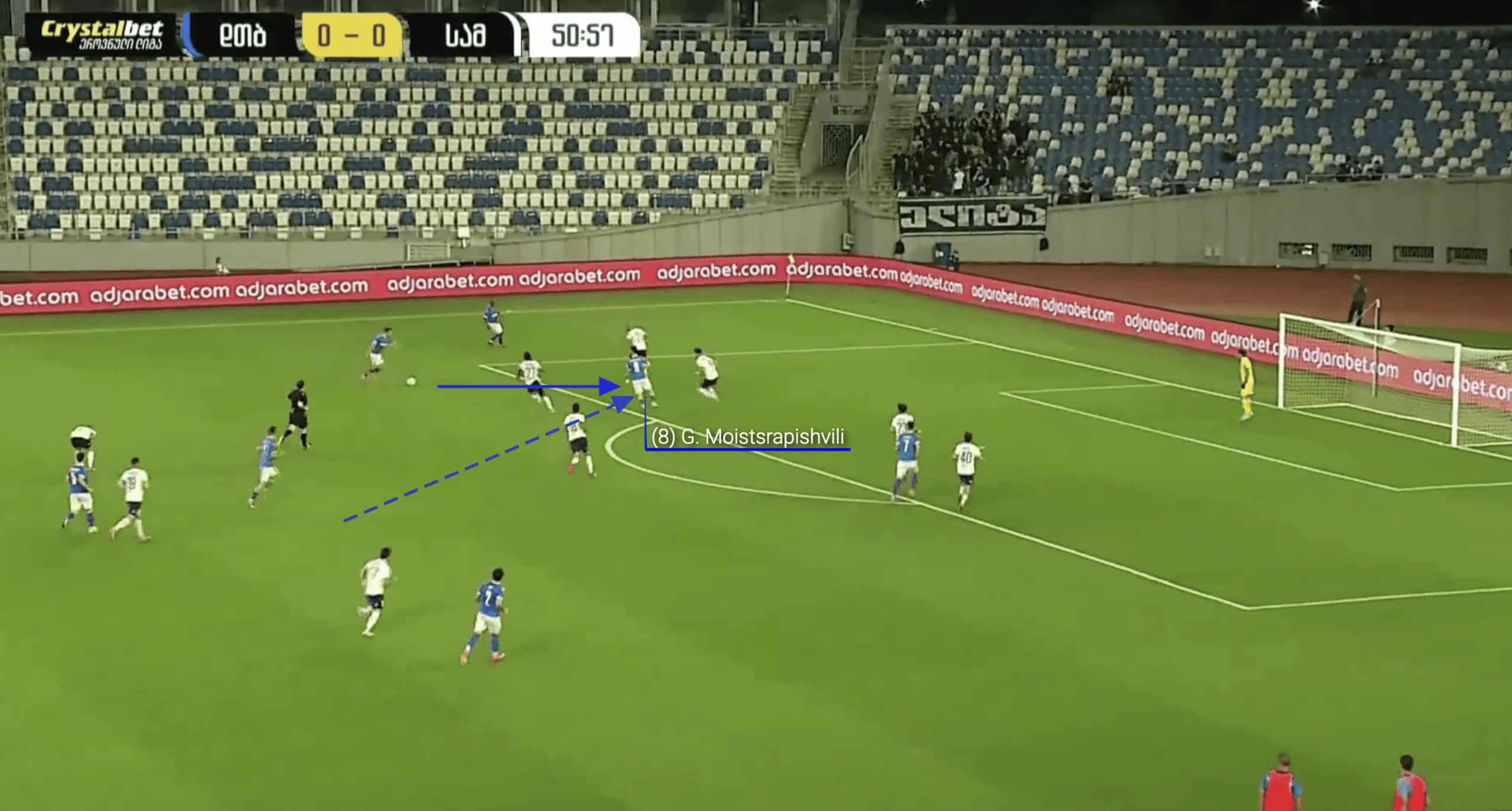
Additionally, Giorgi Moistsrapishvili makes intelligent runs without the ball. He is able to move undetected into pockets of space, particularly in the opposition penalty area, as we can see above. This means he can link up with teammates or use his quick feet and dribbling abilities to carve out an opening for himself. Having scored four so far this season and, as mentioned previously, having only contributed two assists, there is certainly an argument to say that with his level of creativity and on-the-ball abilities, Moistsrapishvili could improve a little more in terms of his goal and assists output.
Giorgi Moistsrapishvili is already proving that he is a very talented midfielder for both club and country. Should he be able to continue showcasing his talents, then it surely won’t be too long before clubs begin to take notice of him.
Zuriko Davitashvili – Bordeaux

Let’s take a closer look at Bordeaux winger Zuriko Davitashvili. The 22-year-old has had quite an interesting journey in his career so far. He started out at the Dinamo Tbilisi Academy before moving on to Locomotive Tbilisi. In 2018, The Guardian newspaper recognised him as one of the 60 players to watch. However, he faced some challenges in Russian football, playing for three different clubs in three years. In 2022, the young player made a wise decision to return home and join Dinamo Batumi, where he impressed by scoring seven goals in 18 appearances.
Following his successful stint at Dinamo Batumi, Davitashvili joined Ligue 2 side Bordeaux on loan for the 2022/23 season. His impact was significant; he made over 30 appearances and contributed six goals to the team. Bordeaux was impressed enough to make the deal permanent at the end of the season.
When comparing Davitashvili to other wingers in Ligue 2 via the pizza chart above, we can see some standout qualities. One area where he excels is in dribbles per 90, indicating his ability to carry the ball up the pitch and take on opposition defenders. Additionally, his goal contributions per 90 exceed his expected goal contributions per 90, which is highly beneficial for the Bordeaux attack. Moreover, Davitashvili actively participates in defensive work and has a reasonable success rate in duels.
Davitashvili’s journeyman career to date and his notable performances in different leagues make him an intriguing player to analyse. His dribbling ability, goal-scoring, and defensive contributions make him a valuable asset for Bordeaux.
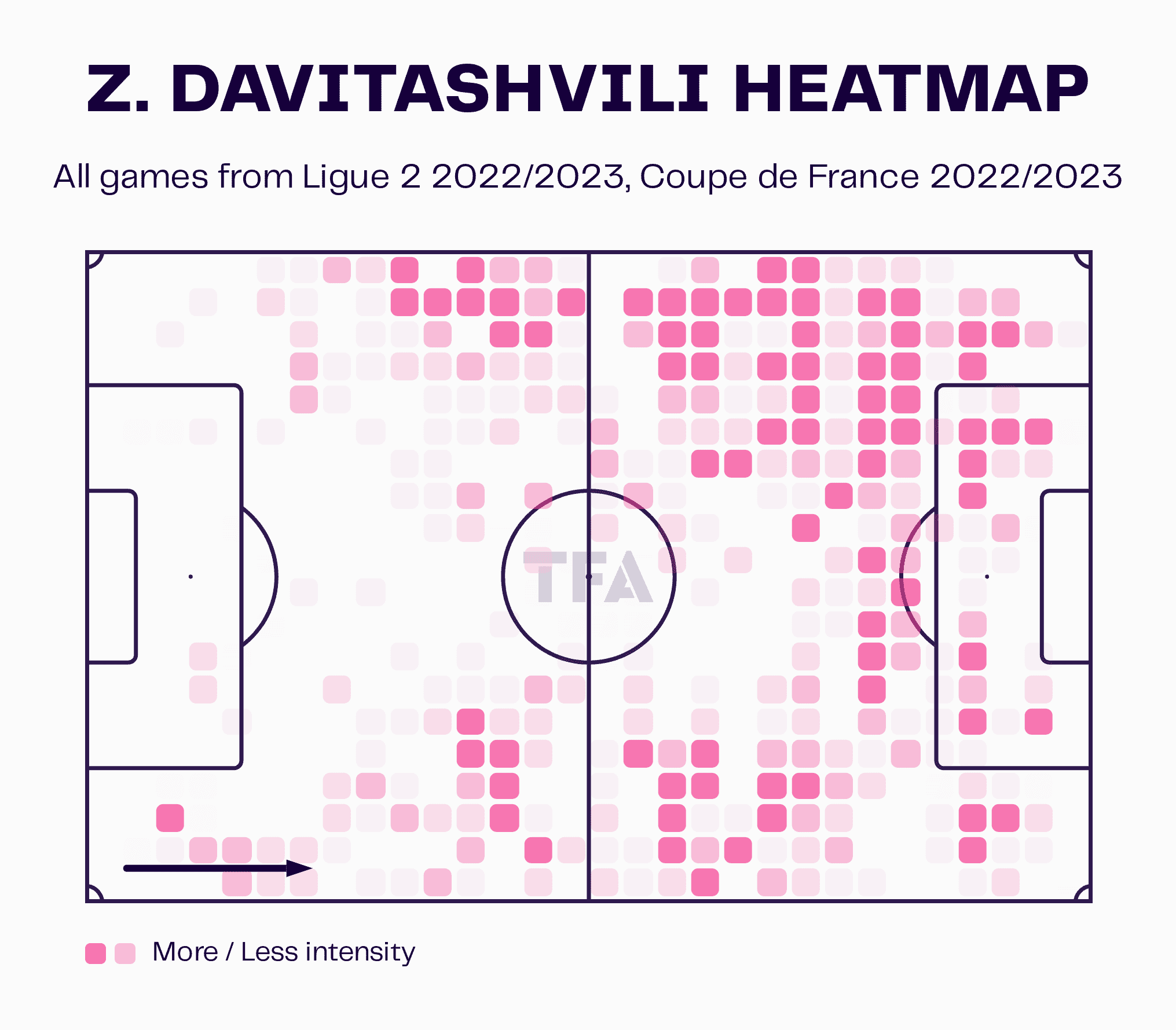
One of Davitashvili’s critical traits as a player is his versatility; he is more than capable of playing as a centre forward, which is where he has recently played for Georgia U21s. At club level, he is typically deployed in wide areas, as the heatmap indicates.
This versatile player brings several advantages to the table. Firstly, his ability to operate on either flank adds unpredictability to the team’s attacking play. Opposing defenders find it challenging to anticipate Davitashvili’s movements, as he can switch sides seamlessly during a match. This element of surprise keeps the opposition off balance and creates opportunities for the team to exploit gaps in the defence.
Moreover, this provides tactical flexibility to Bordeaux’s game plan. The ability to switch flanks allows the team to adjust their attacking strategy on the fly. For example, if the opposing full-back is struggling to contain the winger on one side, the team can quickly shift Davitashvili to the opposite wing to take advantage of a potential weakness there. This adaptability keeps the opposition guessing and forces them to constantly readjust their defensive structure.
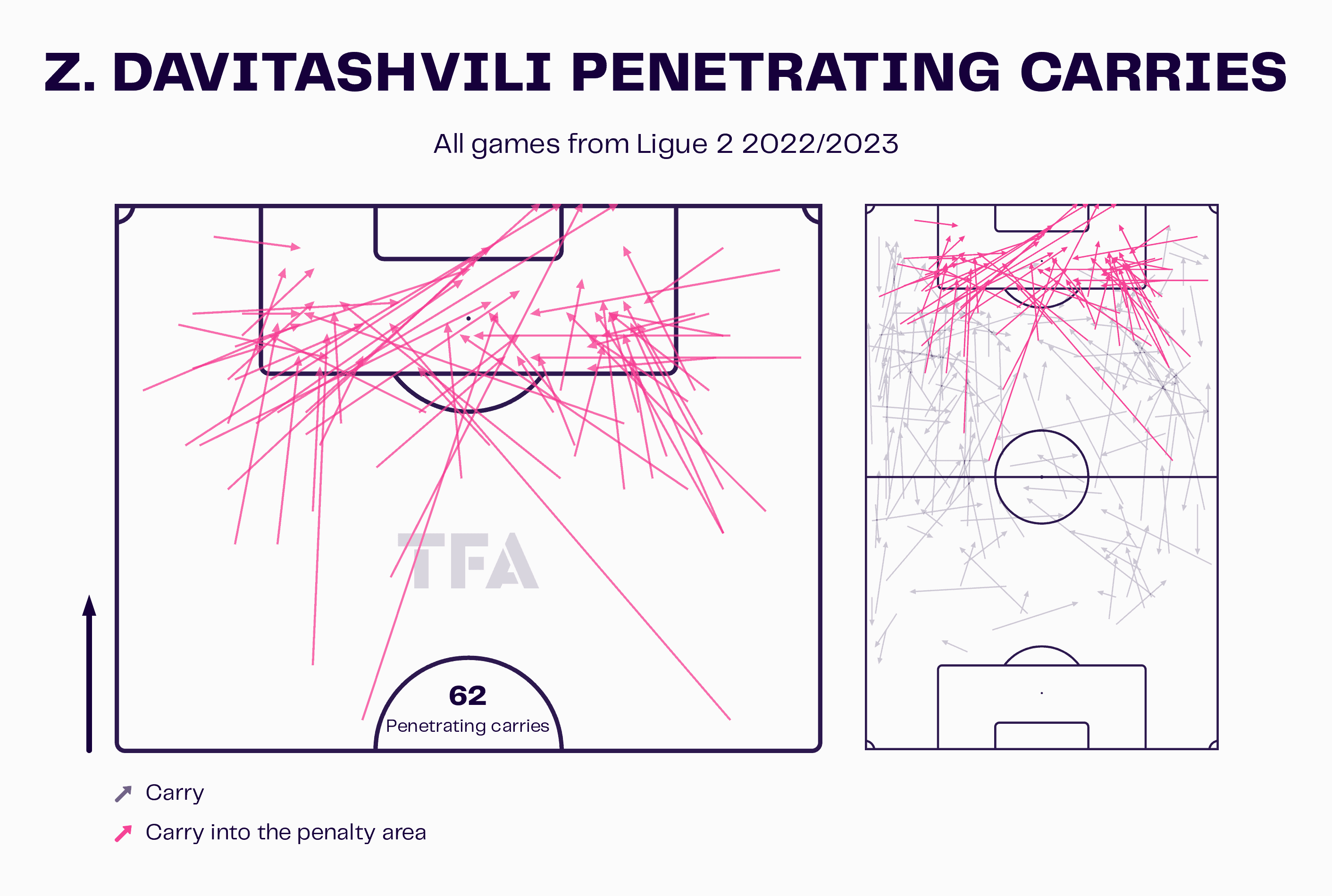
We previously mentioned that Zuriko Davitashvili is a player who enjoys picking up the ball and running at the opposition. We can see from the data visual above that he was able to carry the ball into the opposition penalty area on 62 occasions during the most recent Ligue 2 campaign.
Having a player who enjoys dribbling past opposition defenders is highly advantageous, particularly in the attacking phase and during transitions. This skill set brings several benefits to Bordeaux’s attacking gameplay which increases their chances of scoring.
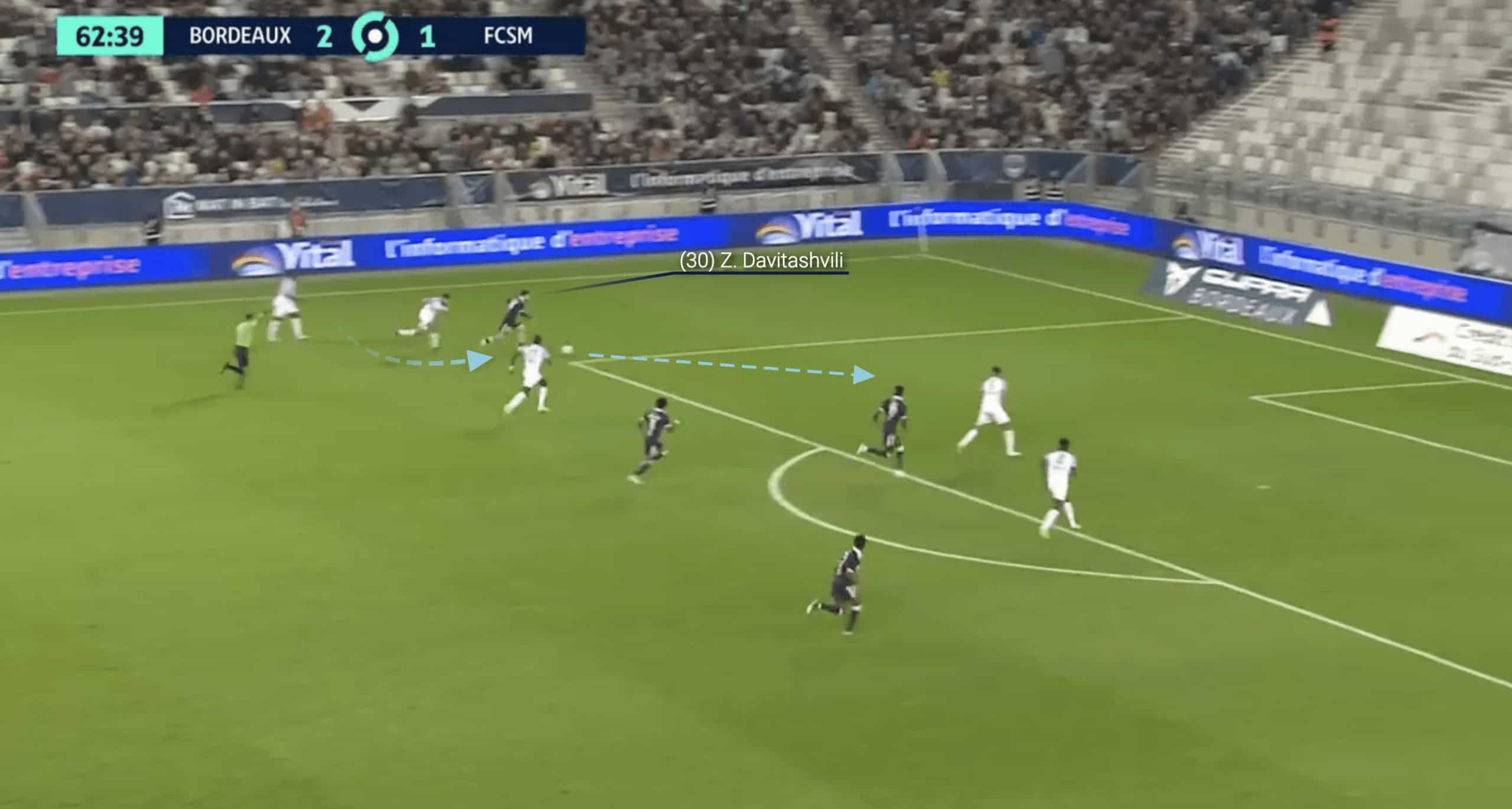
We can see here in the image above that Davitashvili picks up the ball on the left wing for Bordeaux and then is able to use his close control and quick feet to weave his way past two defenders. Davitashvili, who averages 3.14 progressive runs per 90 and 5.59 dribbles per 90, then displays a good burst of acceleration, enabling him to drive into the penalty area before looking to cross the ball to a teammate.
A winger with excellent dribbling ability can penetrate deep into the opposition’s defensive lines, disrupting their shape and creating numerical advantages for the attacking team, as shown above. By dribbling past defenders, Davitashvili can attract multiple opponents, thus forcing them to commit to challenges. This opens up passing lanes and creates opportunities for teammates to receive the ball in dangerous positions, either through quick one-two combinations or through incisive through balls.
Furthermore, in transition moments, the Georgian becomes a valuable asset for Bordeaux. When the team wins possession and looks to launch a counter-attack, his ability to carry the ball up the pitch quickly and bypass opposition defenders can be instrumental. His dribbling skills allow him to evade opposition challenges and maintain possession, buying time for the rest of the team to join the attack and set up scoring opportunities.
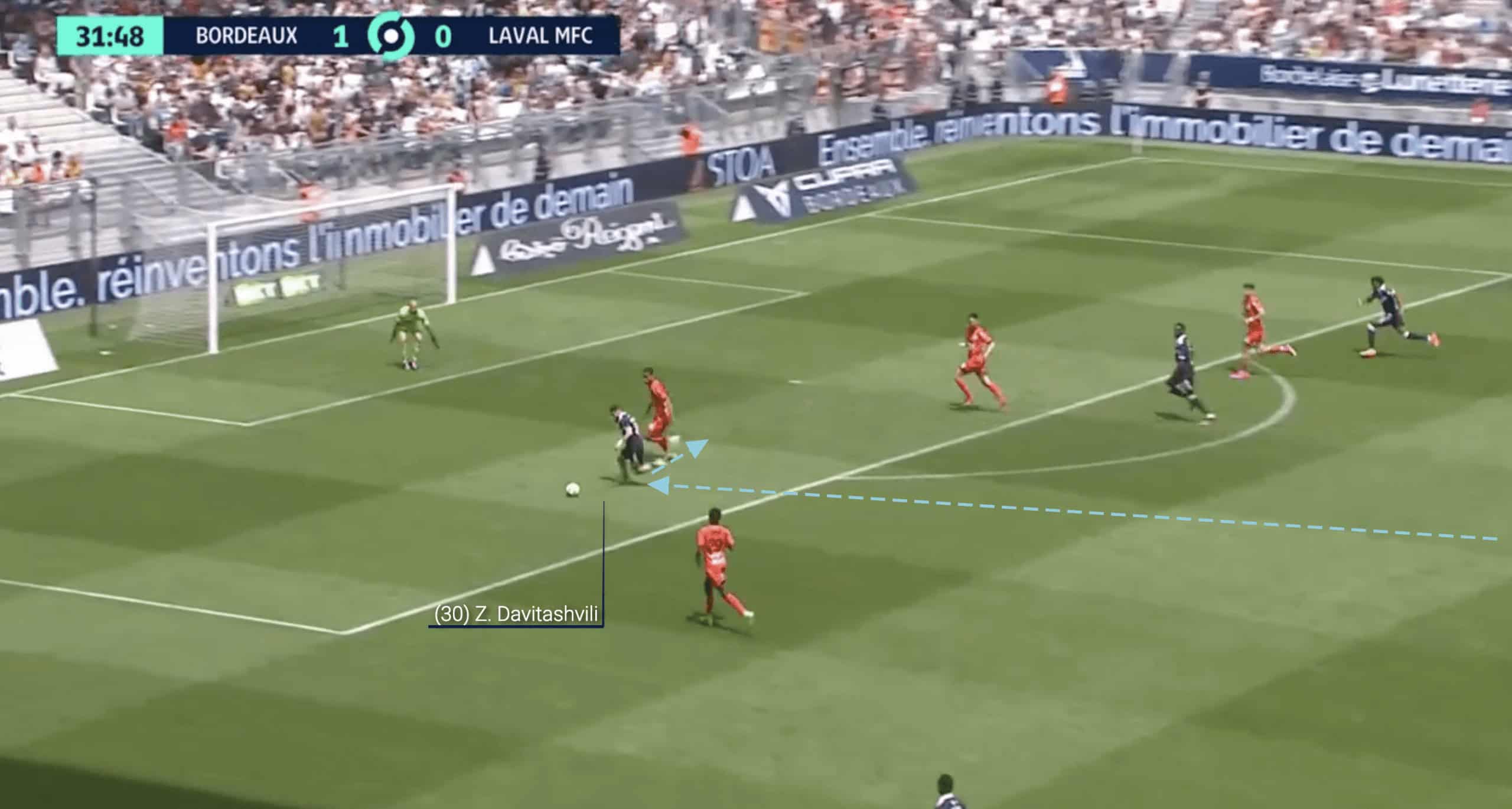
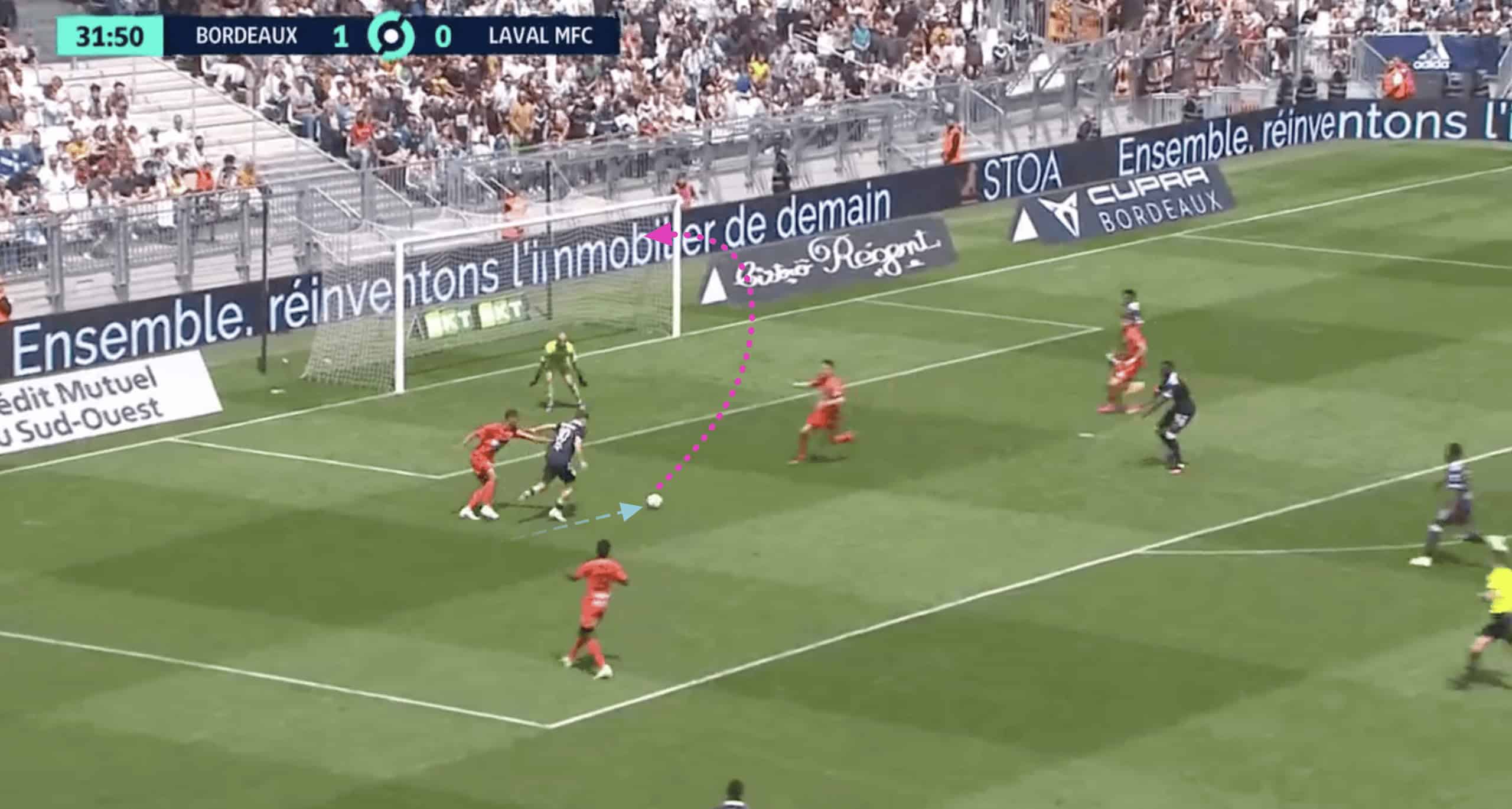
Davitashvili possesses good strength and agility, which sees him being able to change direction quickly. Above, we can see the Bordeaux man demonstrating his ability to carry the ball into the opposition penalty area. He can then quickly drag the ball back, which creates plenty of space for him to score a curling shot that nestles in the top corner.
As we have seen, Davitashvili can use his close ball control to navigate tight spaces in the penalty area. In crowded situations, where defenders are in close proximity, the attacker’s close control allows him to manoeuvre past challenges, maintain possession, and create shooting opportunities. His ability to keep the ball close to his feet enables him to change direction quickly, deceive defenders, and find gaps to unleash accurate shots on goal.
Moreover, he is able to execute intricate dribbling moves in the penalty area. Through quick turns, feints, and changes of pace, he can create space to shoot or pass to teammates. This skill not only puts the defender on the backfoot but also draws their attention, potentially creating openings for other attacking players to exploit.
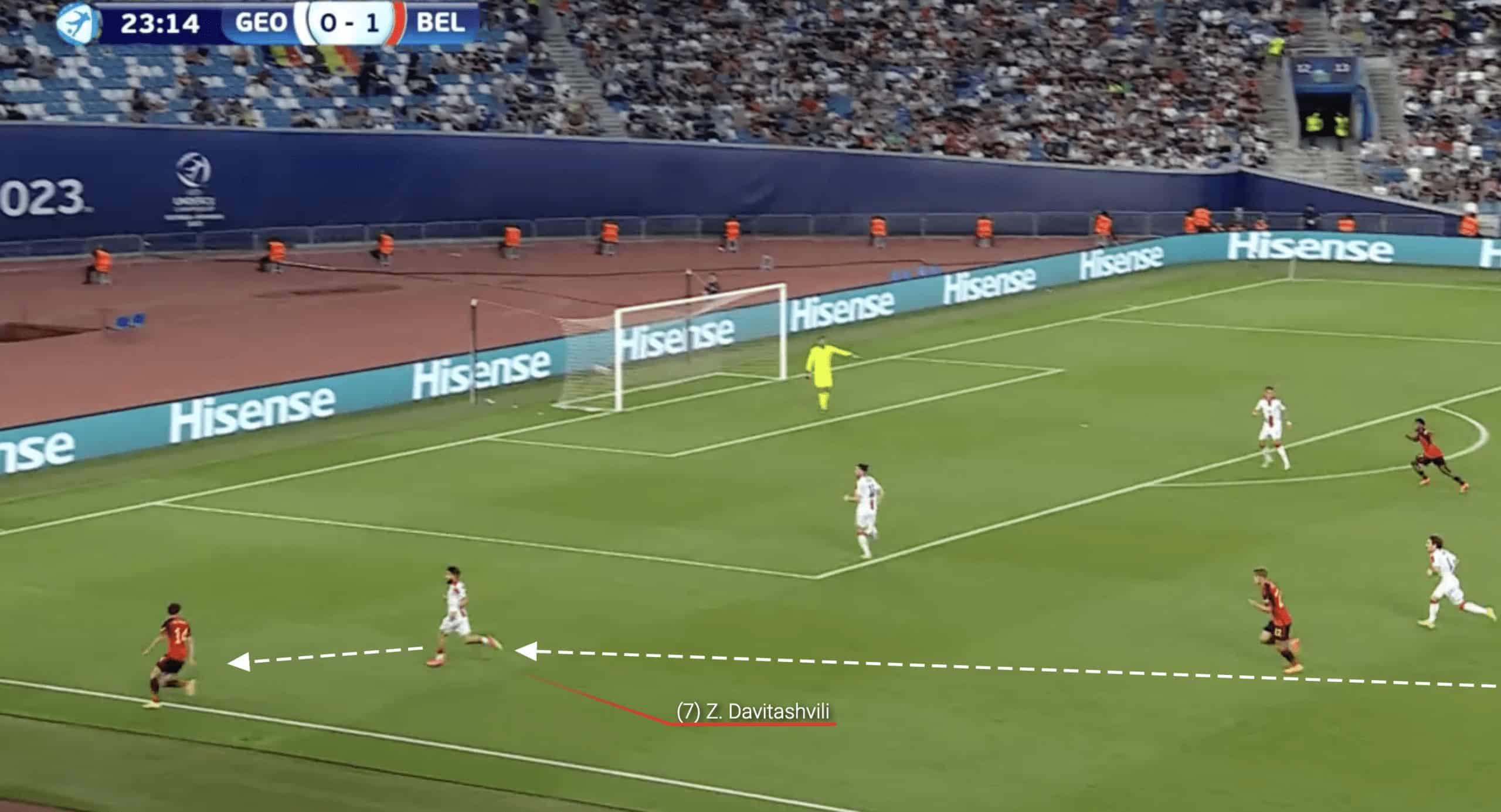
Finally, it is essential to acknowledge that the Georgian winger is happy to track back in order to limit the opposition’s attacking capabilities. We can see in the image above that he has followed the Belgian attacker and is looking to close him down to prevent him from being able to get a cross into the box.
By dropping deeper and helping out in defensive duties, Davitashvili is able to contribute to a compact defensive structure. This makes it harder for the opposition to exploit the spaces in wide areas and reduces the number of crossing opportunities or through balls that can be played into the box. The winger’s presence in the defensive phase adds an extra layer of protection, making it more challenging for the opposing team to break through.
Moreover, it means that his team can effectively double up on opposition attackers, especially in wide areas. By providing defensive cover alongside the full-back, the team can create numerical superiority and apply pressure on the opposition player in possession. This cooperative defensive effort helps to regain control, disrupt the opposition’s attacking flow, and limit their options for advancing into dangerous areas.
On the whole, Davitashvili didn’t enjoy the best of times in Russia. However, the return to Batumi and then the move to Bordeaux appears to have reignited his career. Having joined the French club permanently now, it seems the Georgian forward has a club that he can call home as they look to return to Ligue 1 football.
Irakli Azarovi – Crvena Zvezda
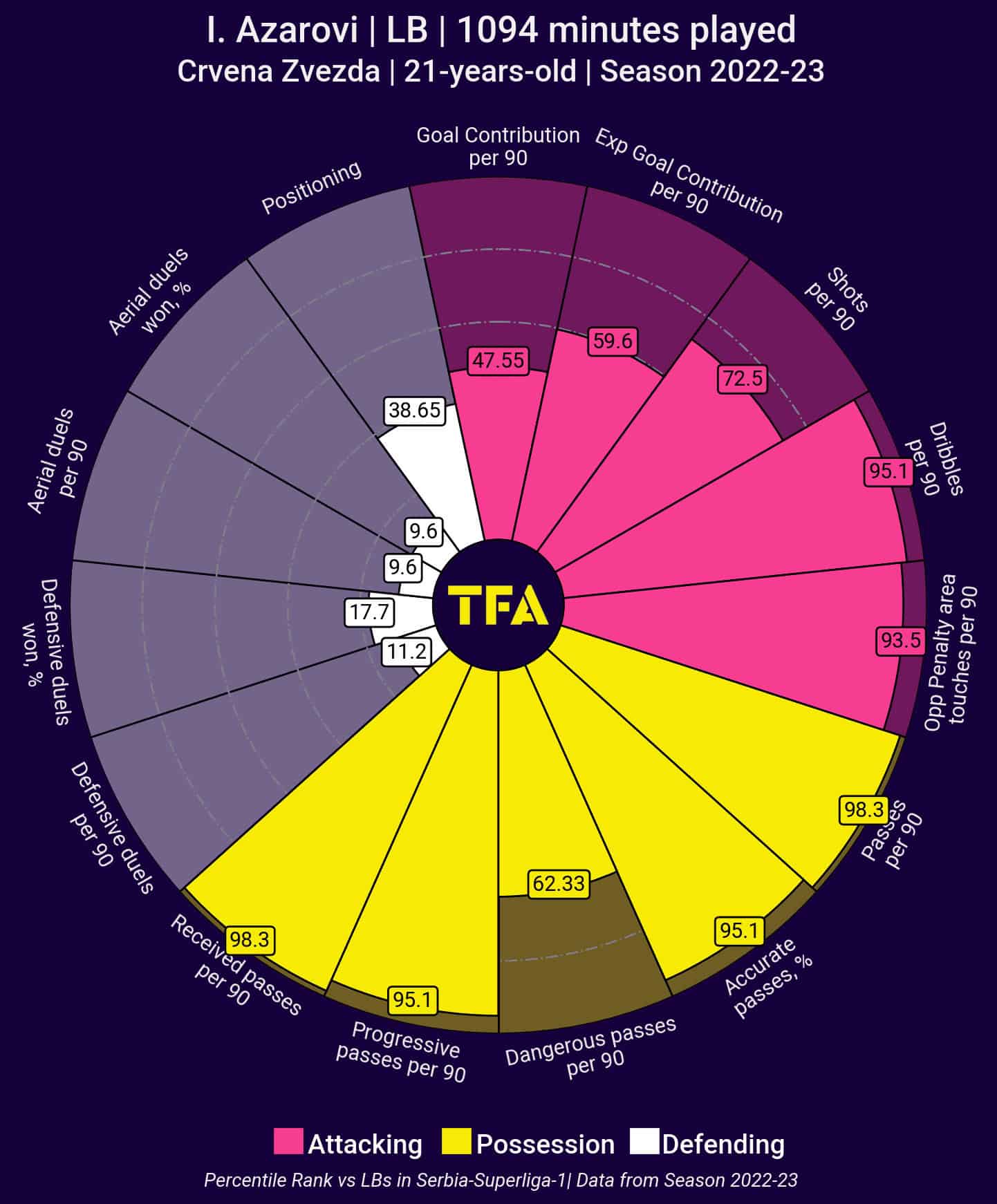
Let’s now analyse the 21-year-old left-back Irakli Azarovi. The Georgian defender began his career at Dinamo Tbilisi, joining their academy system at the age of 10. He achieved success with the club, winning two league titles in 2019 and 2020. Azarovi then made a move to Dinamo Batumi, where he continued his winning streak and earned another title winners medal. In 2021, he received recognition as the Best Young Georgian Player and earned a call-up to the senior national team. His impressive performances attracted interest from teams outside Georgia, leading to his move to Serbian giants Crvena Zvezda (Red Star Belgrade) in 2022. During his time there, he has already played a vital role in the club winning the 2022-2023 Serbian SuperLiga and their performances in the UEFA Europa League, where they were somewhat unlucky not to make it beyond the group stage.
From the pizza chart above, we can see that Azarovi stands out when in possession of the ball. He ranks incredibly high in terms of his progressive passes and accuracy, which means that his teammates can not only rely on him to progress the play effectively, but they can also be sure his passes will reach their intended target. The left-back likes to carry the ball forwards, which is particularly useful when transitioning from defence to attack. Whilst his defensive performance may appear on the low side, it is necessary to remember that when playing for Crvena Zvezda, who won the league title 20 points ahead of their closest rivals, the young player isn’t required to do too much defending; therefore the statistics are much more skewed towards his attacking performance.
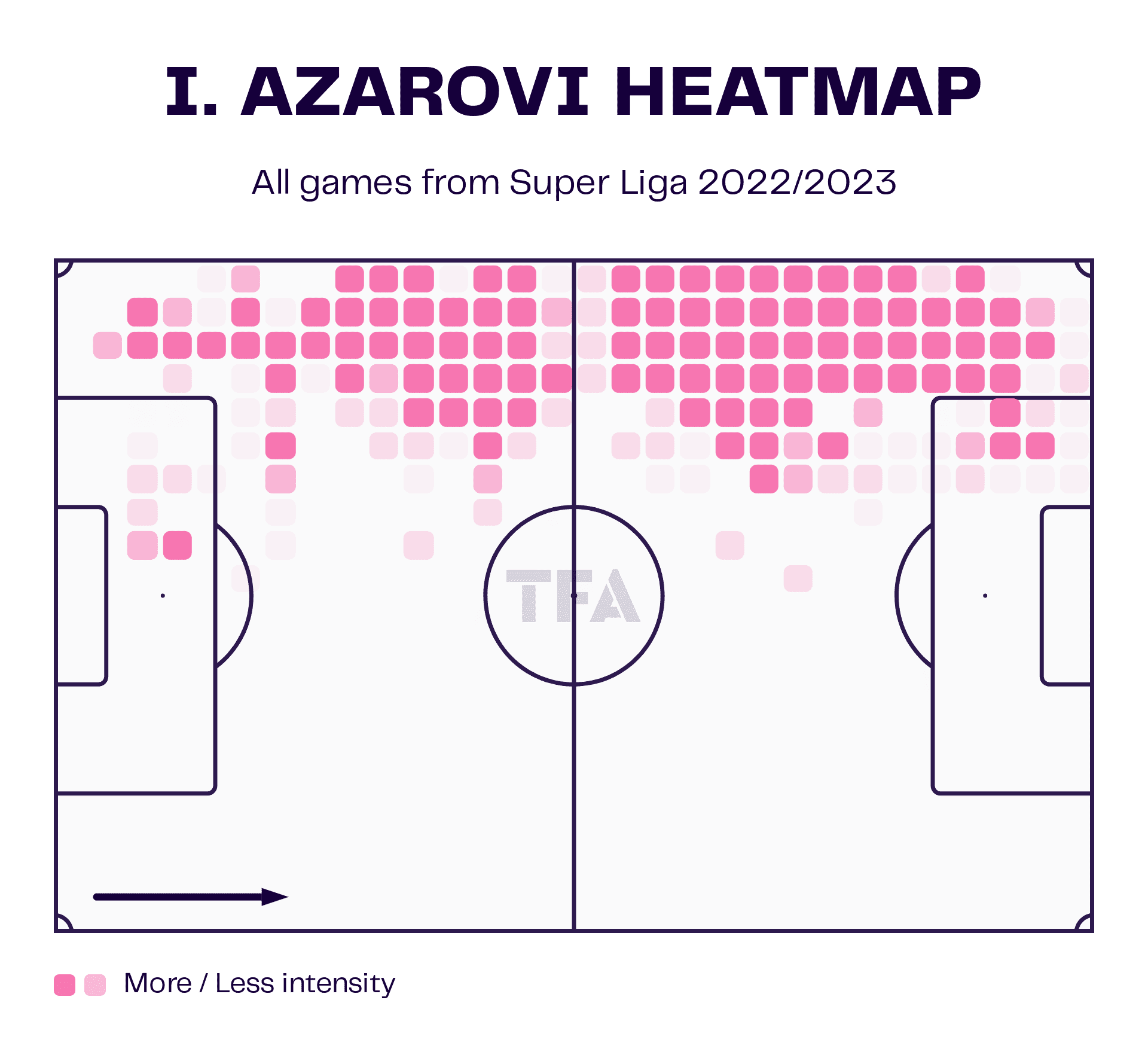
Azarovi is a left-back who likes to stay wide so he can contribute significantly to the team’s attacking buildup, as shown in the heatmap above. By positioning himself higher up the pitch and offering an overlapping or underlapping option, he becomes an additional attacking threat. His runs down the flank not only provide width but also create confusion in the opposition’s defensive structure. This movement can draw defenders out of position, create space for other players to exploit, and open up crossing or cutback opportunities for scoring chances.
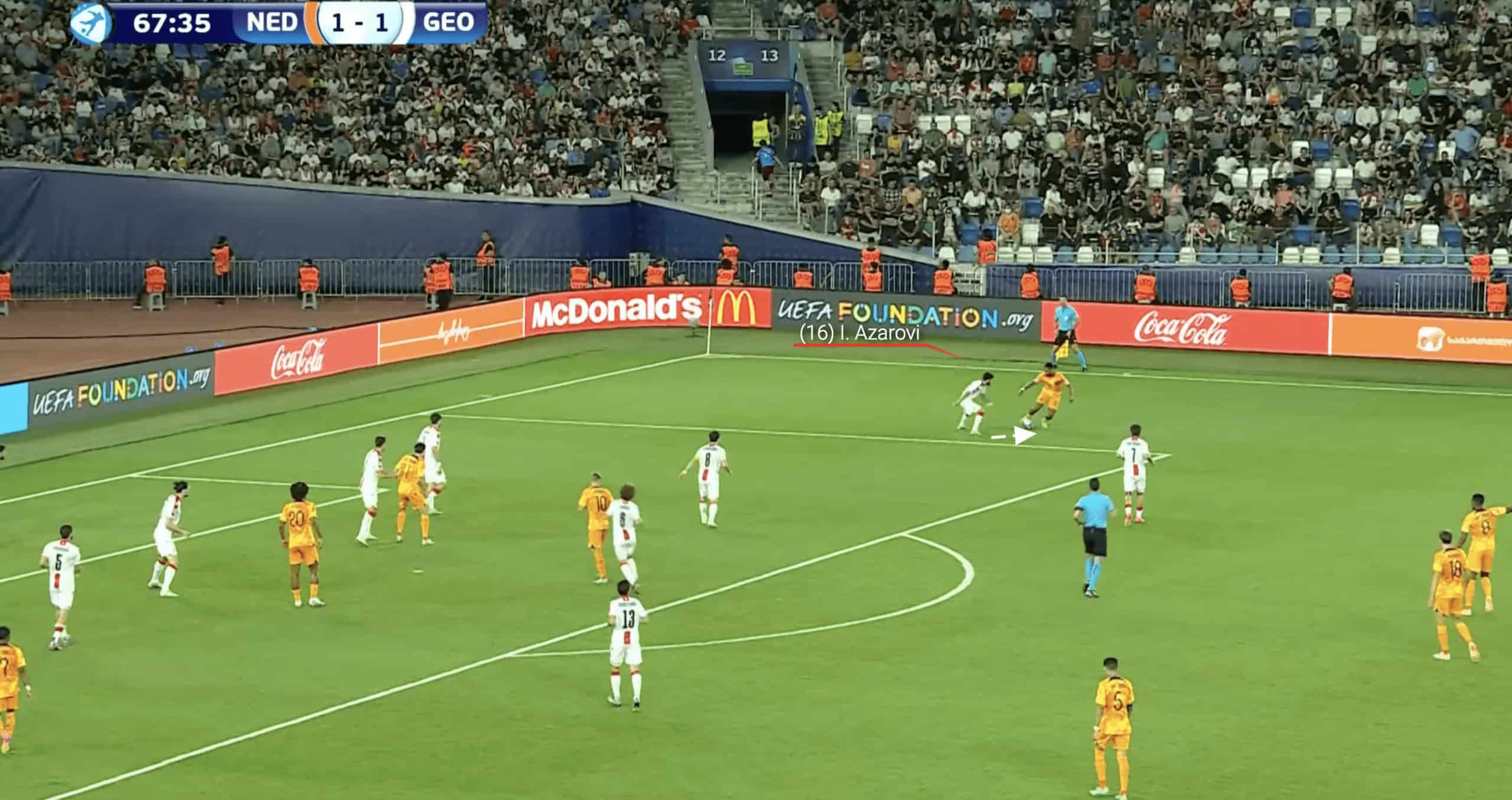
In terms of his defensive capabilities, Azarovi proves to be a knowledgeable player. Firstly, Azarovi is very good in 1v1 defending, which provides a reliable defensive barrier on the flank. His ability to effectively mark and contain opposing attackers in one-on-one situations, as seen above, limits the opponent’s attacking options and reduces the likelihood of them successfully penetrating the defensive line. We can see in the image above that Azarovi is able to stay close to the opposition player and ensure that he is unable to play a pass into the penalty area. By applying pressure and staying tight to his opponent, he forces the attacker into a less threatening area, making it difficult for him to create any goal-scoring opportunities.
Moreover, Irakli Azarovi mostly avoids going to ground to tackle which displays discipline and intelligent defensive decision-making. He reduces the risk of being easily bypassed or committing unnecessary fouls by staying on his feet and maintaining a good defensive stance. This discipline also ensures that his team remains in control of the situation, allowing them to react quickly to changes in the opponent’s movement or play style.
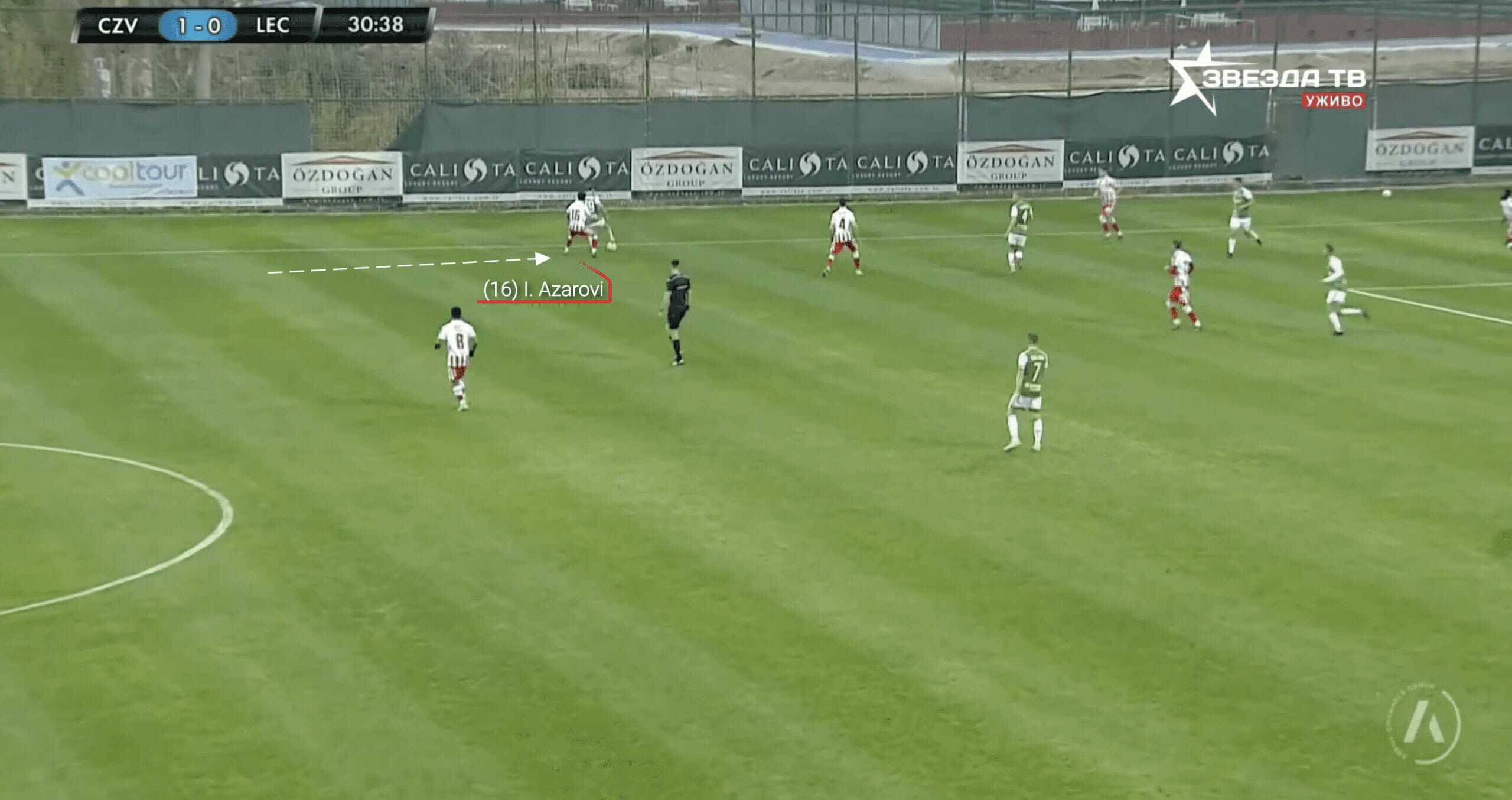
We can see in the image above how Azarovi likes to press his opponent high up the pitch, which enables his team to regain possession and counter quickly. Additionally, Azarovi can read the play well, which can be a crucial defensive asset. His ability to anticipate and understand the movements of opposing players, as well as the overall flow of the game, allows him to position himself effectively. This positioning enables Azarovi to make interceptions, averaging 3.21 per 90 and cut off passing lanes.
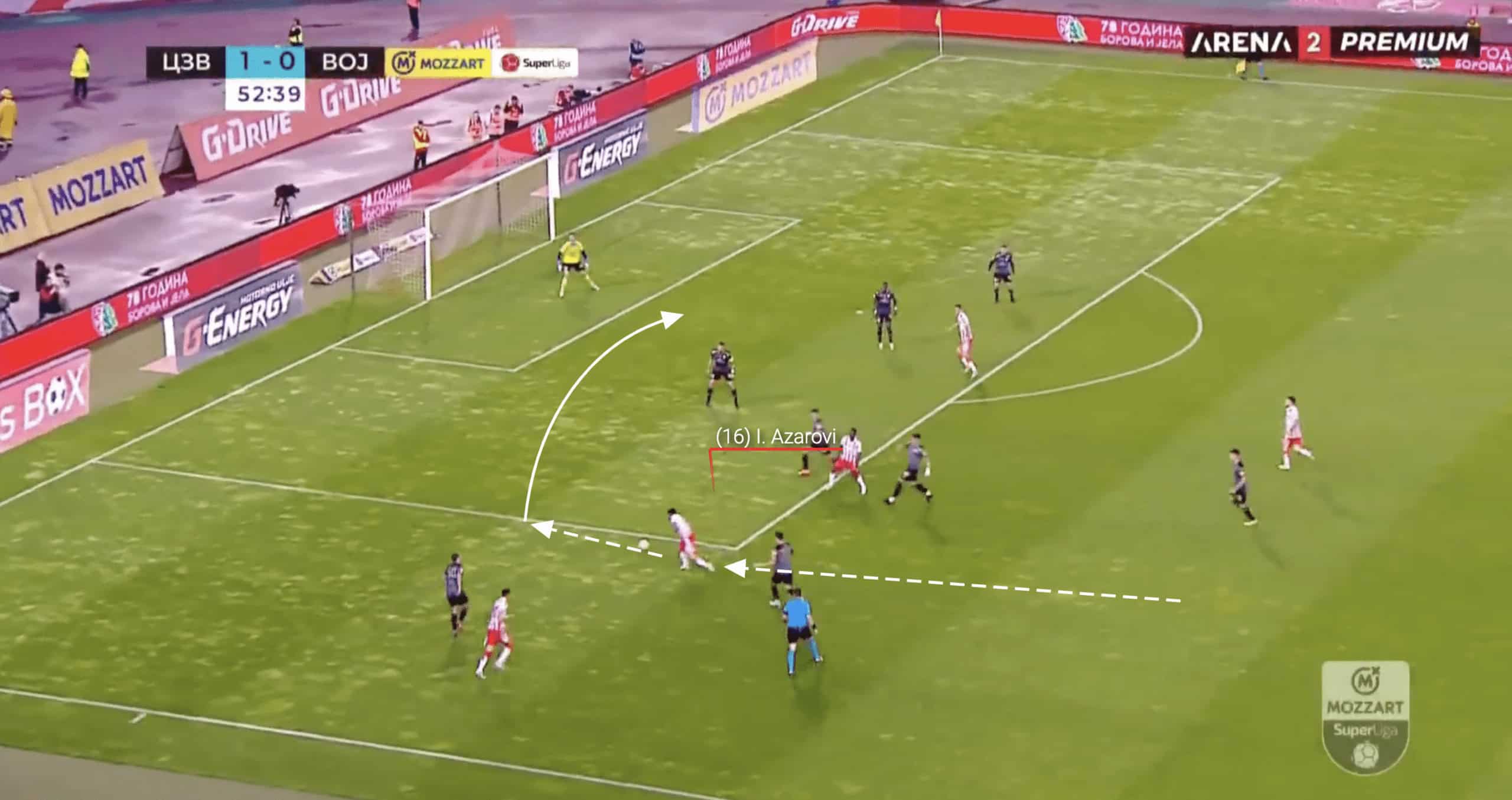
Here, we can see how Azarovi contributes to the attacking phase for Crvena Zvezda. We saw from the heatmap that the left-back is very active in the attacking third, which of course, is incredibly beneficial to his team. He is very astute and knows when to make underlapping or overlapping runs, allowing his teammates to use him as a viable passing outlet.
Moreover, we can see from the data visual below that Azarovi makes most of his progressive passes from the left wing area into the penalty area. By venturing forward and delivering accurate passes into the penalty area, Azarovi becomes an additional creative outlet and contributes to the team’s overall attacking threat.


Additionally, Azarovi is incredibly competent at carrying the ball into the box. From the data visual above, we can see that he provides an additional attacking outlet by doing this. When a full-back is responsible for carrying the ball forward, it catches the opposing defenders off guard and forces them to adjust their defensive positions. This opens up space for other attacking players to exploit and creates new passing options in the final third.

Irakli Azarovi also makes these runs out of possession too; as we can see above, he is making a run from inside his own half to the opposition penalty area, where he can receive a pass and either play a pass across the face of goal or take a shot on himself.
As we can see, the left-back’s willingness to work hard, especially in the attacking transitions, adds an extra option for quick and effective counter-attacks. As the team regains possession, he is able to quickly travel up the pitch as his teammates initiate fast attacking moves. His involvement in the transition phase provides an outlet for the team to promptly switch from defence to attack, catching the opposition off guard and capitalising on the element of surprise.
Overall then, Irakli Azarovi is a very talented defender who is already making a name for himself in Serbian football. Should he continue this trajectory, it won’t be long before clubs in the top five European leagues start to take note.
Conclusion
In this scout report, we have covered three Georgian players who we think it’s worth keeping an eye on in the future. There is a resurgence going on in Georgian football, and clubs are producing some incredibly gifted players from their youth systems, ‘Kvaradona’ being the most obvious example. Truthfully though, there are many talented players in the Erovnuli Liga and the Georgian national set-up. It is worth watching the league as some of these players will no doubt be on the radar of some of Europe’s top clubs, and we may see some exciting transfers during the next few seasons.





Comments